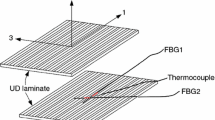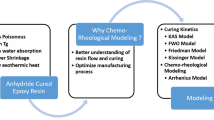Abstract
Ambient temperature curing epoxy resins are widely used as the matrix material in fibre reinforced plastics in the marine and wind energy sectors, where they are popular due to their relatively high mechanical performance yet low processing and tooling costs. To date, the characterisation of ambient curing epoxy resins has been limited to relatively simple measures, not suitable for use in heat transfer and flow process models. A complete cure kinetics and rheology model allows the prediction of the progression of degree of cure and viscosity for any time–temperature history. The progression of degree of cure of two epoxy resin systems was measured by differential scanning calorimeter and fitted to an nth order model incorporating vitrification effects. Viscosity was measured using an oscillatory rheometer and fitted to a model from the literature. The resulting cure kinetics and rheology model enables the improvement of resin infusion and wet layup processes by providing a thorough understanding of the interlinked relationship between time, temperature, degree of cure and viscosity.















Similar content being viewed by others
References
Hubert P, Johnston A, Poursartip A, Nelson K (2001) In: 33rd International SAMPE Technical Conference, Long Beach, CA
Seifi R, Hojjati M (2005) J Compos Mater 39(11):1027. doi:10.1177/0021998305048738. http://jcm.sagepub.com/content/39/11/1027.abstract
Lee CL, Wei KH (2000) J Appl Polym Sci 77(10):2139. http://dx.doi.org/10.1002/1097-4628(20000906)77:10<2139::AID-APP6>3.0.CO;2-N
Lee JH, Lee JW (1994) Polym Eng Sci 34(9):742. http://dx.doi.org/10.1002/pen.760340907
Um MK, Daniel IM, Hwang BS (2002) Compos Sci Technol 62(1):29. doi:10.1016/S0266-3538(01)00188-9. http://www.sciencedirect.com/science/article/B6TWT-44RNMX5-5/2/6fea2018ba34d39301af6c490cf92a3d.0266-3538
Wen X, Wang X, Cai ZQ, Pi P, Cheng J, Yang Z (2011) High Perform Polym 23(6):477. doi:10.1177/0954008311417024. http://hip.sagepub.com/content/23/6/477.abstract
Khoun L, Centea T, Hubert P (2010) J Compos Mater 44(11):1397. doi:10.1177/0021998309353960. http://jcm.sagepub.com/content/44/11/1397.abstract
Cole KC, Hechler JJ, Noel D (1991) Macromolecules 24(11):3098. http://dx.doi.org/10.1021/ma00011a012
Montserrat S (1992) J Appl Polym Sci 44(3):545. http://dx.doi.org/10.1002/app.1992.070440319
Dusi MR, Lee WI, Ciriscioli PR, Springer GS (1987) J Compos Mater 21(3):243. http://jcm.sagepub.com/content/21/3/243.abstract
Kenny JM, Apicella A, Nicolais L (1989) Polym Eng Sci 29(15):973. doi:10.1002/pen.760291502. http://dx.doi.org/10.1002/pen.760291502
Grimsley B (2005) Master’s thesis, Virginia Polytechnic Institute and State University
Di Benedetto AT (1987) J Polym Sci Part B: Polym Phys 25(9):1949. http://dx.doi.org/10.1002/polb.1987.090250914
Acknowledgements
The authors would like to acknowledge the assistance of the McGill University Structures and Composite Materials Laboratory, particularly Associate Professor Pascal Hubert, Dr Lolei Khoun, James Kratz and Timotei Centea.
Author information
Authors and Affiliations
Corresponding author
Rights and permissions
About this article
Cite this article
Hickey, C.M.D., Bickerton, S. Cure kinetics and rheology characterisation and modelling of ambient temperature curing epoxy resins for resin infusion/VARTM and wet layup applications. J Mater Sci 48, 690–701 (2013). https://doi.org/10.1007/s10853-012-6781-8
Received:
Accepted:
Published:
Issue Date:
DOI: https://doi.org/10.1007/s10853-012-6781-8




